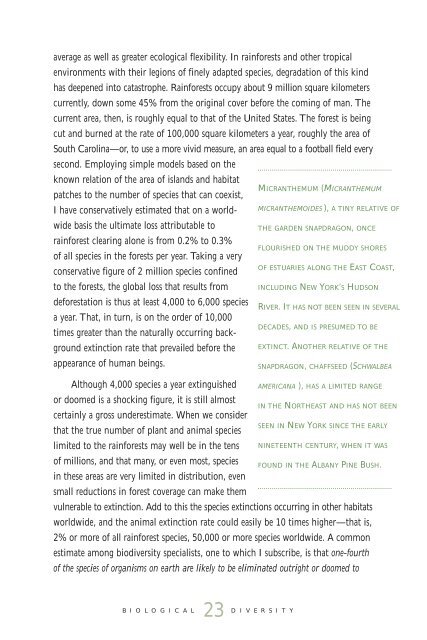Download Biological Diversity - New York State Museum
Download Biological Diversity - New York State Museum
Download Biological Diversity - New York State Museum
Create successful ePaper yourself
Turn your PDF publications into a flip-book with our unique Google optimized e-Paper software.
average as well as greater ecological flexibility. In rainforests and other tropical<br />
environments with their legions of finely adapted species, degradation of this kind<br />
has deepened into catastrophe. Rainforests occupy about 9 million square kilometers<br />
currently, down some 45% from the original cover before the coming of man. The<br />
current area, then, is roughly equal to that of the United <strong>State</strong>s. The forest is being<br />
cut and burned at the rate of 100,000 square kilometers a year, roughly the area of<br />
South Carolina—or, to use a more vivid measure, an area equal to a football field every<br />
second. Employing simple models based on the<br />
known relation of the area of islands and habitat<br />
patches to the number of species that can coexist,<br />
I have conservatively estimated that on a worldwide<br />
basis the ultimate loss attributable to<br />
rainforest clearing alone is from 0.2% to 0.3%<br />
of all species in the forests per year. Taking a very<br />
conservative figure of 2 million species confined<br />
to the forests, the global loss that results from<br />
deforestation is thus at least 4,000 to 6,000 species<br />
a year. That, in turn, is on the order of 10,000<br />
times greater than the naturally occurring background<br />
extinction rate that prevailed before the<br />
appearance of human beings.<br />
Although 4,000 species a year extinguished<br />
or doomed is a shocking figure, it is still almost<br />
certainly a gross underestimate. When we consider<br />
that the true number of plant and animal species<br />
limited to the rainforests may well be in the tens<br />
of millions, and that many, or even most, species<br />
in these areas are very limited in distribution, even<br />
small reductions in forest coverage can make them<br />
MICRANTHEMUM (MICRANTHEMUM<br />
MICRANTHEMOIDES ), A TINY RELATIVE OF<br />
THE GARDEN SNAPDRAGON, ONCE<br />
FLOURISHED ON THE MUDDY SHORES<br />
OF ESTUARIES ALONG THE EAST COAST,<br />
INCLUDING NEW YORK’S HUDSON<br />
RIVER. IT HAS NOT BEEN SEEN IN SEVERAL<br />
DECADES, AND IS PRESUMED TO BE<br />
EXTINCT. ANOTHER RELATIVE OF THE<br />
SNAPDRAGON, CHAFFSEED (SCHWALBEA<br />
AMERICANA ), HAS A LIMITED RANGE<br />
IN THE NORTHEAST AND HAS NOT BEEN<br />
SEEN IN NEW YORK SINCE THE EARLY<br />
NINETEENTH CENTURY, WHEN IT WAS<br />
FOUND IN THE ALBANY PINE BUSH.<br />
vulnerable to extinction. Add to this the species extinctions occurring in other habitats<br />
worldwide, and the animal extinction rate could easily be 10 times higher—that is,<br />
2% or more of all rainforest species, 50,000 or more species worldwide. A common<br />
estimate among biodiversity specialists, one to which I subscribe, is that one-fourth<br />
of the species of organisms on earth are likely to be eliminated outright or doomed to<br />
B i o l o g i c a l<br />
23 D i v e r s i t y
















